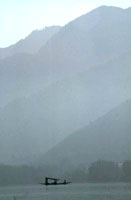Prospects of an `Irreversible Peace Process` in Kashmir
 |
Following his two-day visit to the Indian capital President General Parvez Musharraf and Prime Minister Dr. Monmohan Singh in a joint statement have expressed their determination to continue their "irreversible peace" initiatives.
National press in both countries and the international press have welcomed their determination. Many international leaders have also expressed their confidence in this process. Prospects for peace in the area should look bright if this is true and sincere. But any political observer should examine the statement carefully. Is it a sincere statement of facts or just political rhetoric? The Indian authorities allowed President Musharraf to meet a number of Kashmiri leaders, and this must be viewed as a positive sign. Such a meeting has not been viewed Pakistan's interference into Indian international affairs. However, later responding to a question in the Indian Parliament Dr. Singh reiterated India's earlier position that under no circumstances India was going to compromise on the existing borders in Kashmir. This raises question about the intention of the Indian government on the issue.
Historical Kashmir is currently divided in three nation-states: China, India and Pakistan. This internationally declared disputed territory has been the nucleus of tension in the area which has caused at least two hot wars during the past century. Following the first war (1948) both countries sought a diplomatic and civilized solution to the conflict through UN mediation. Both countries agreed to conduct a plebiscite under the UN supervision, i.e. let the people of Kashmir decide the future of their territory. However, disagreement occurred on the methodology of conducting the plebiscite. Like Israel India flouted all mediation efforts initiated not only by the UN, but also of the Commonwealth. Following another war in 1965 the former Soviet Union unsuccessfully attempted to find a solution to the conflict. In 1971 taking the advantage of an internal conflict, India forced Pakistan to declare the issue to be a bilateral one thus practically shutting down all international mediation efforts. The people of Kashmir continued to suffer.
It was therefore natural for the victims to take the advantage of the situation in next door Afghanistan where in the 1980s the freedom fighters were courageously fighting the Soviet occupation of their territory. For the people of Kashmir taking arms against Indian occupation forces was absolutely legitimate, and the Kashmiri struggle took a new turn in 1989. Pakistanis also found it logical to provide necessary support to Kashmiri fighters who were providing similar support to the Afghans with complete backing of the international community. The consequences, however, were different: while in Afghanistan the Soviets evacuated, in Kashmir the Indians imported more than half a million troops to fight what they called terrorism. The term terrorism seemed to attract sympathy from many in the media and political establishments without realizing that on many occasions established states have created more terror than the so-called terrorists themselves.
In any attempt to resolve the crisis one must understand the problem of the victims who have been denied the right to self-determination for almost two generations. And this has happened only because of India's arrogant denial of international mediation. It is interesting to note that when in 1998 the Kashmiri fighters with direct assistance from Pakistani armed forces occupied strategically important Kargil mountaintop located in Indian occupied Kashmir, India sought Washington's help to get out of the crisis. It was embarrassing for India to admit that the Pakistani backed militias succeeded in capturing Kargil in spite of the heavy presence of regular Indian armed forces with sophisticated weapons. Washington was kind enough to intervene in order to avoid a nuclear disaster. But neither Washington nor Delhi wanted to extend this intervention for a long term solution involving the UN and the indigenous people of Kashmir.
A number of steps have been taken to reduce tension between India and Pakistan: among them are the so-called cricket diplomacy, bilateral trade and bus and train communication. How can a friendly cricket match ease tension if fans supporting India begin to throw bottles at crease when their team is about to loose? And this has happened more than once. Bilateral trade also so far has been heavily in favor of India; this will not help easing tension unless the authorities intervene in equalizing the trade flow between the two countries. The attempt increase bus and train links is the only step which will help the common people of the area. But again, the terrorists have taken advantage of these soft targets to disrupt the process.
President Musharraf is reported to have committed to stop "cross-border" terrorism. But one must remember that the General was never elected by the people of Pakistan. In our opinion until and unless opinion of the people of Kashmir are taken into consideration and that is ensured by some form international mediation both the freedom fighters and terrorists will find support both side of the divide. And that is a disgrace for the humanity at large.
Professor Abdullah Ahsan is a faculty member at International Islamic University, Kuala Lumpur
Source: Zaman
Topics: Foreign Policy, India, India-Pakistan Relations, Kashmir, Pakistan, Pervez Musharraf
Views: 3939
Related Suggestions

















